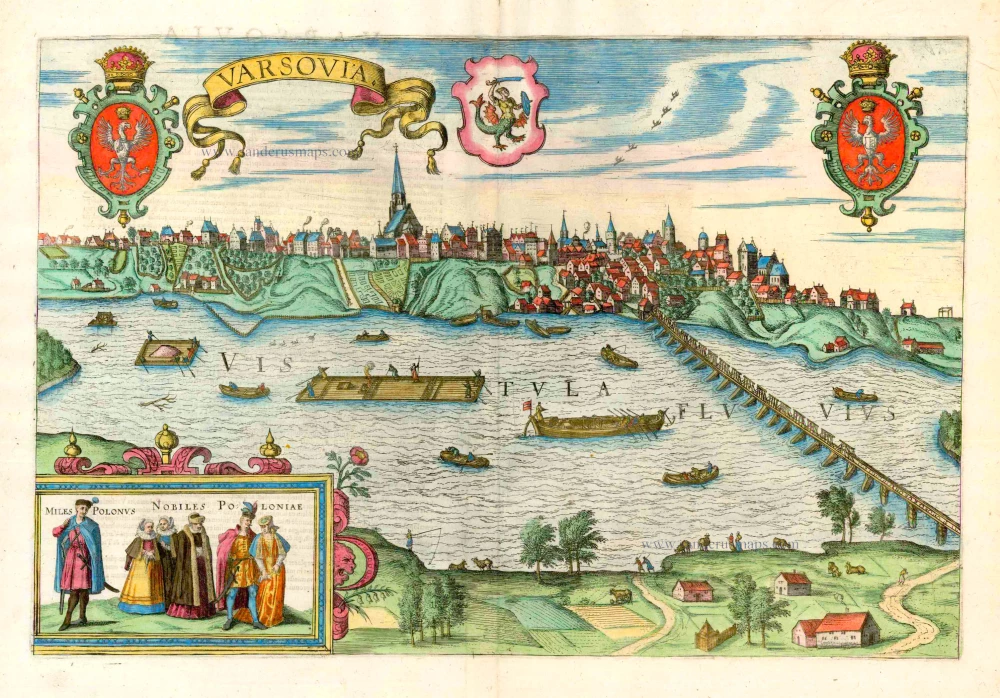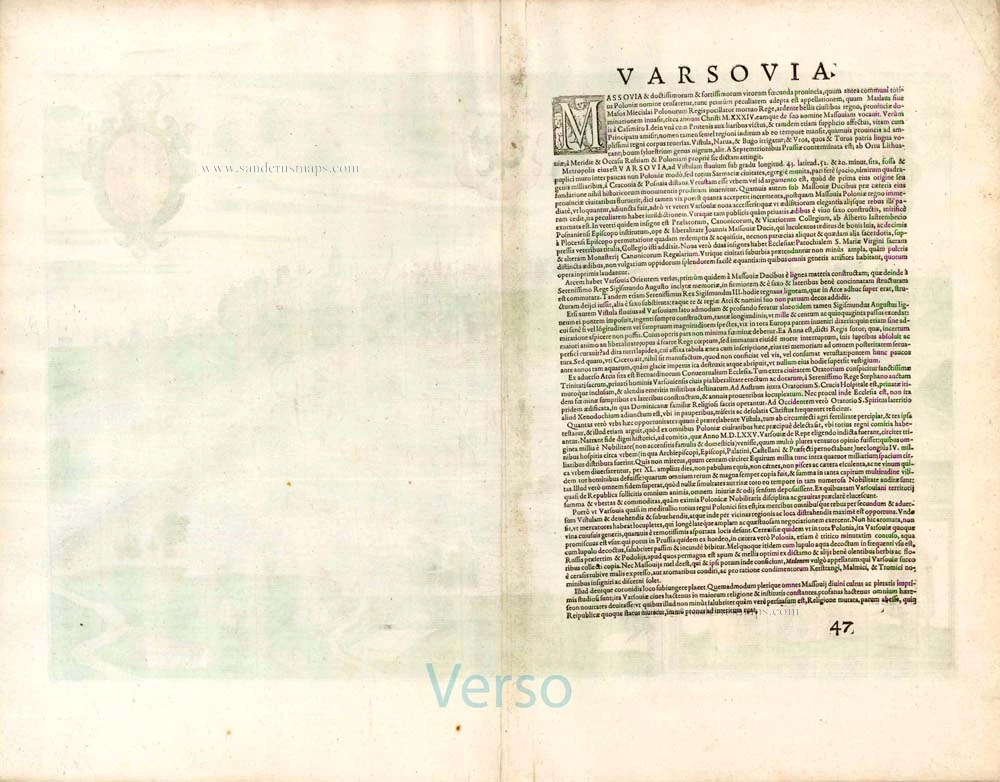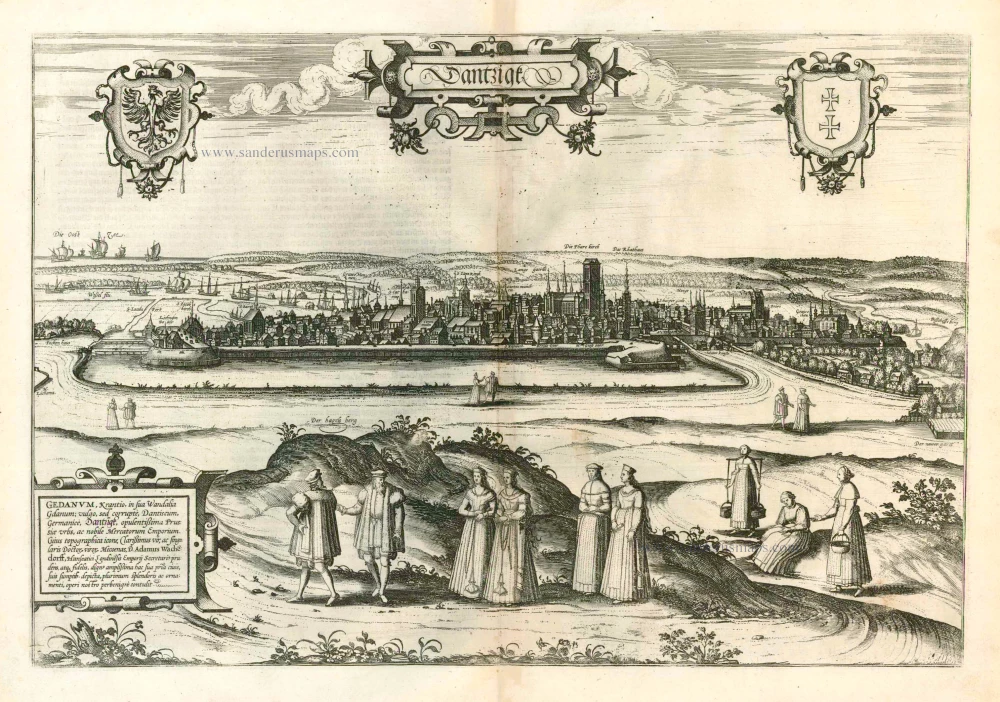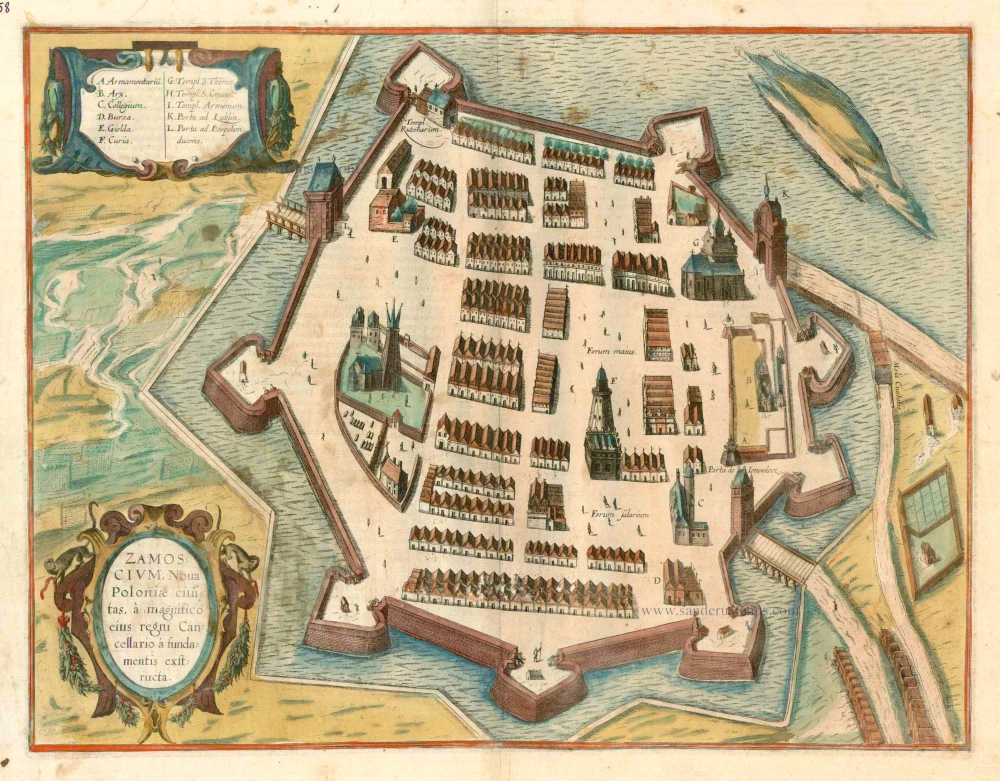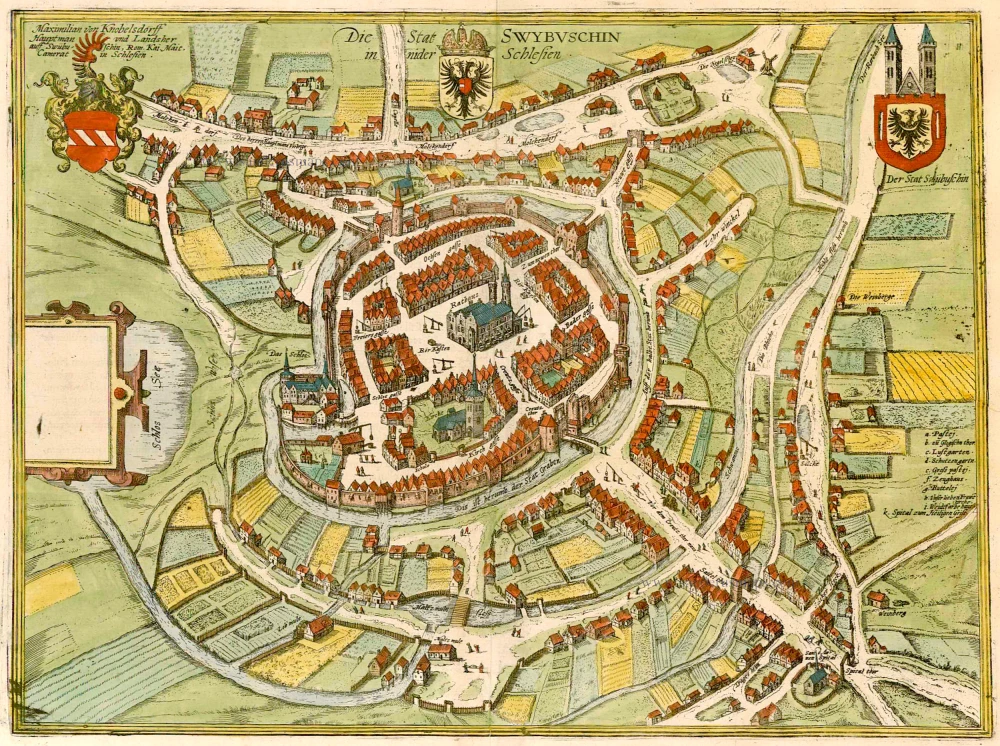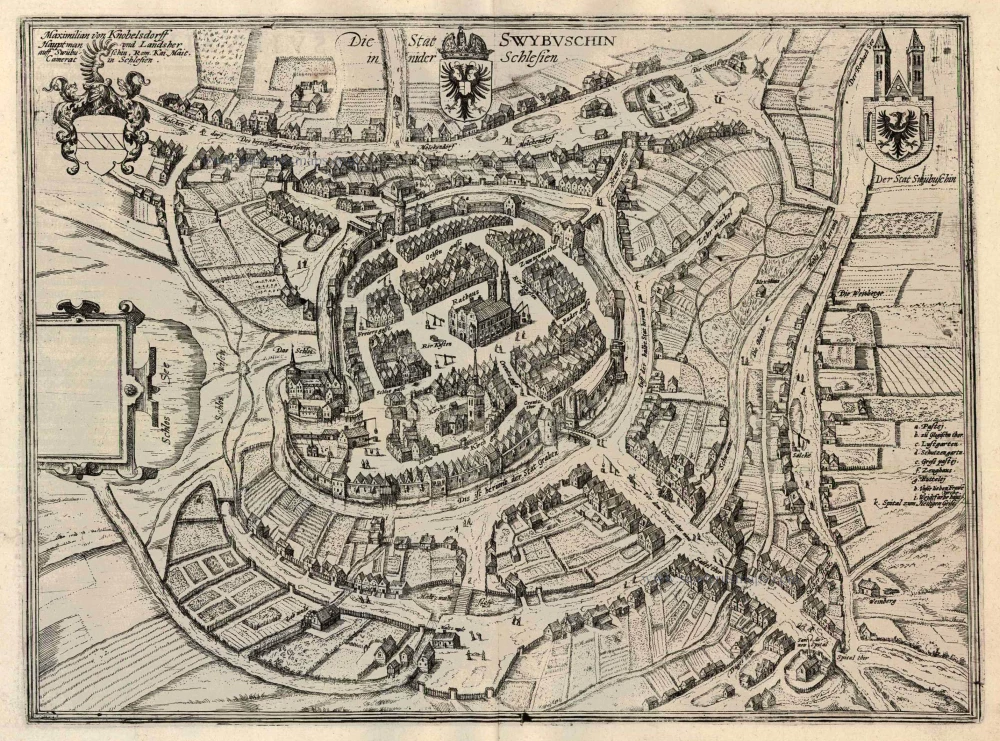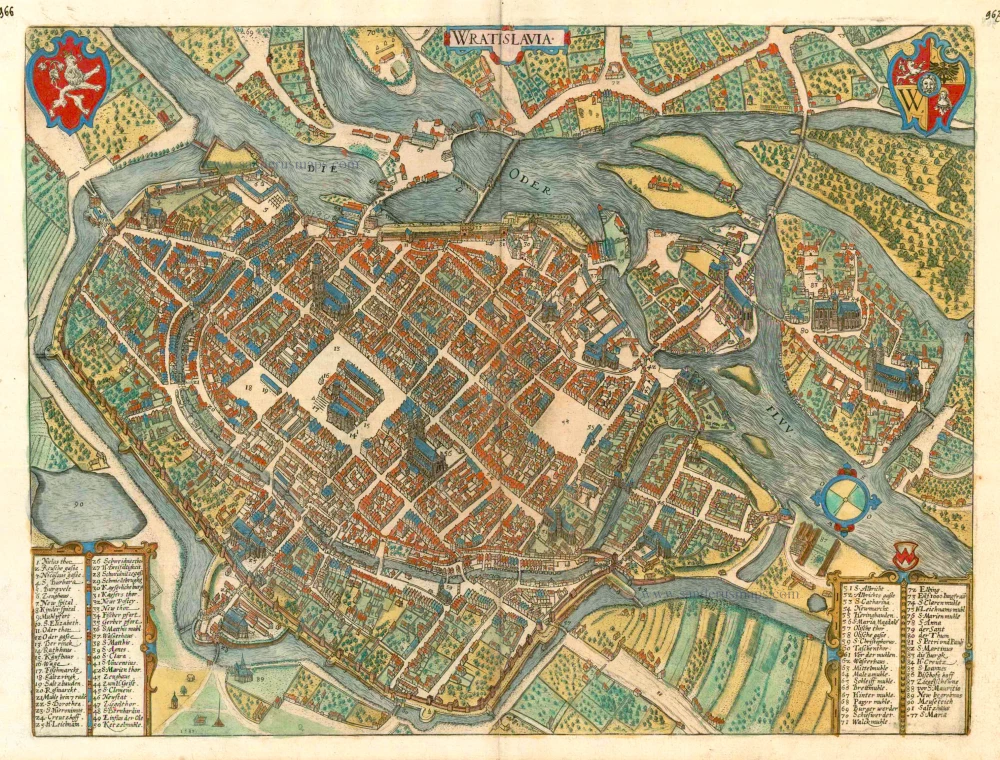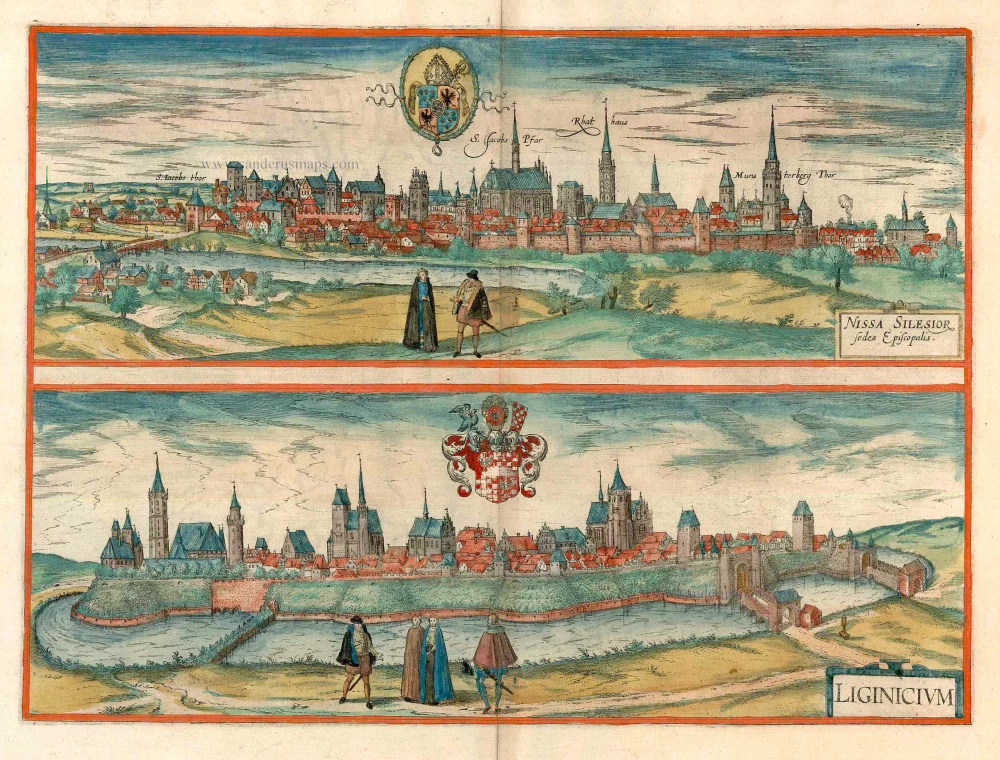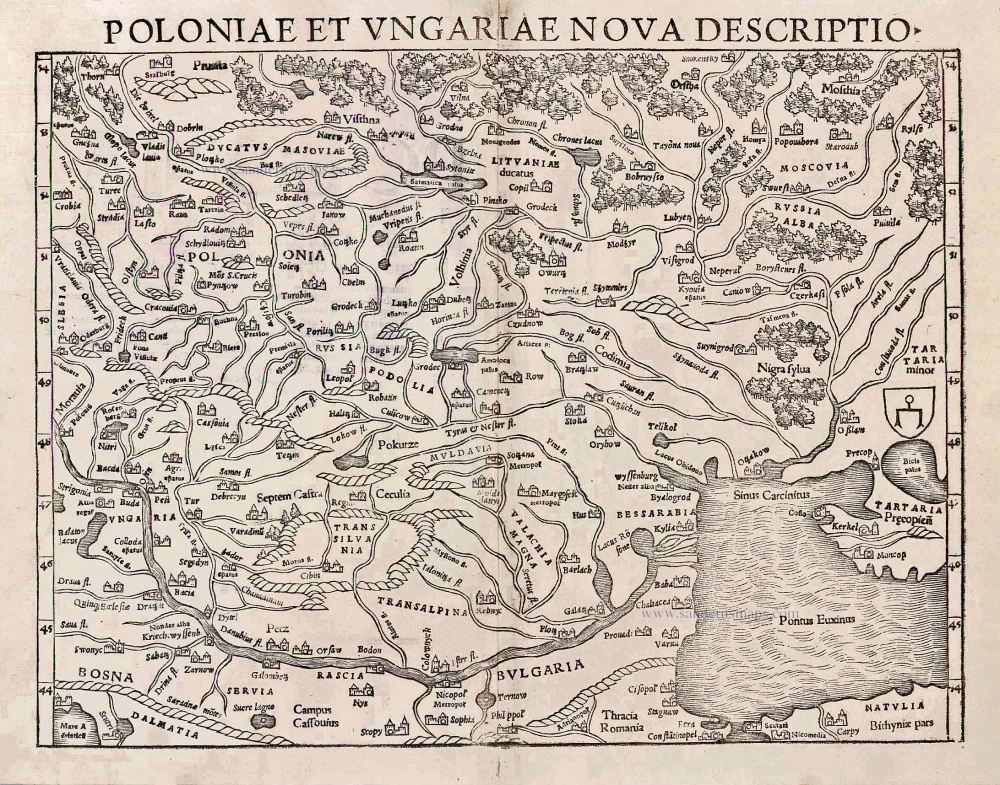Old, antique map - Bird's-eye view of Warsaw (Warszawa) by Braun and Hogenberg 1635
COMMENTARY BY BRAUN (on verso): "The most distinguished city in Warsaw, situated on the River Vistula [...]. It may be well be that at the time when it still belonged to the Dukes of Masovia this city enjoyed greater prosperity than other cities. Nevertheless, after passing to the Polish crown penniless, as one might say, it developed so fast that in a short time one city became two, the new one being built on to the old one, both of them having similar buildings yet different jurisdictions and municipal charters. In both cities the houses and other buildings are built of stone, which is rare in Poland." The city is shown from the east bank of the Vistula, with a view of bustling river traffic. The narrow bridge over the river was contructed in 1573. Warsaw was founded at the beginning of the 14th century. After the creation of the Polish-Lithuanian Union it became the centre of the new state, and the residence of the Polish kings was moved from Cracow to Warsaw in the years 1598-1611. This plate obviously originates from an earlier period: there is nothing to indicate that the city is a royal residence; the 14th-century castle is shown and not the palace, and there is no mention of a royal residence in the commentary. In addition, the 14th-century church of St John (centre) is shown with the tower that collapsed is 1602. (Taschen)
Braun G. & Hogenberg F. and the Civitates Orbis Terrarum.
The Civitates Orbis Terrarum, also known as the 'Braun & Hogenberg', is a six-volume town atlas and the most excellent book of town views and plans ever published: 363 engravings, sometimes beautifully coloured. It was one of the best-selling works in the last quarter of the 16th century. Georg Braun, a skilled writer, wrote the text accompanying the plans and views on the verso. Many plates were engraved after the original drawings of a professional artist, Joris Hoefnagel (1542-1600). The first volume was published in Latin in 1572 and the sixth in 1617. Frans Hogenberg, a talented engraver, created the tables for volumes I through IV, and Simon van den Neuwel made those for volumes V and VI. Other contributors were cartographers Daniel Freese and Heinrich Rantzau, who provided valuable geographical information. Works by Jacob van Deventer, Sebastian Münster, and Johannes Stumpf were also used as references. Translations appeared in German and French, making the atlas accessible to a wider audience.
Since its original publication of volume 1 in 1572, the Civitates Orbis Terrarum has left an indelible mark on the history of cartography. The first volume was followed by seven more editions in 1575, 1577, 1582, 1588, 1593, 1599, and 1612. Vol.2, initially released in 1575, saw subsequent editions in 1597 and 1612. The subsequent volumes, each a treasure trove of historical insights, graced the world in 1581, 1588, 1593, 1599, and 1606. The German translation of the first volume, a testament to its widespread appeal, debuted in 1574, followed by the French edition in 1575.
Several printers were involved: Theodor Graminaeus, Heinrich von Aich, Gottfried von Kempen, Johannis Sinniger, Bertram Buchholtz, and Peter von Brachel, all of whom worked in Cologne.
Georg Braun (1541-1622)
Georg Braun, the author of the text accompanying the plans and views in the Civitates Orbis Terrarum, was born in Cologne in 1541. After his studies in Cologne, he entered the Jesuit Order as a novice, indicating his commitment to learning and intellectual pursuits. In 1561, he obtained his bachelor's degree; in 1562, he received his Magister Artium, further demonstrating his academic achievements. Although he left the Jesuit Order, he continued his studies in theology, gaining a licentiate in theology. His theological background likely influenced the content and tone of the text in the Civitates Orbis Terrarum, adding a unique perspective to the work.
Frans Hogenberg (1535-1590)
Frans Hogenberg was a Flemish and German painter, engraver, and mapmaker. He was born in Mechelen as the son of Nicolaas Hogenberg.
By the end of the 1560s, Frans Hogenberg was employed upon Abraham Ortelius's Theatrum Orbis Terrarum, published in 1570; he is named an engraver of numerous maps. In 1568, he was banned from Antwerp by the Duke of Alva and travelled to London, where he stayed a few years before emigrating to Cologne. He immediately embarked on his two most important works, the Civitates, published in 1572 and the Geschichtsblätter, which appeared in several series from 1569 until about 1587.
Thanks to large-scale projects like the Geschichtsblätter and the Civitates, Hogenberg's social circumstances improved with each passing year. He died as a wealthy man in Cologne in 1590.
Varsovia
Item Number: 10172 Authenticity Guarantee
Category: Antique maps > Europe > Eastern Europe
Old, antique map - Bird's-eye view of Warsaw (Warszawa), by Georg Braun and Frans Hogenberg.
Inset with costumed figures.
COMMENTARY BY BRAUN (on verso): "The most distinguished city in Warsaw, situated on the River Vistula [...]. It may be well be that at the time when it still belonged to the Dukes of Masovia this city enjoyed greater prosperity than other cities. Nevertheless, after passing to the Polish crown penniless, as one might say, it developed so fast that in a short time one city became two, the new one being built on to the old one, both of them having similar buildings yet different jurisdictions and municipal charters. In both cities the houses and other buildings are built of stone, which is rare in Poland."
The city is shown from the east bank of the Vistula, with a view of bustling river traffic. The narrow bridge over the river was contructed in 1573. Warsaw was founded at the beginning of the 14th century. After the creation of the Polish-Lithuanian Union it became the centre of the new state, and the residence of the Polish kings was moved from Cracow to Warsaw in the years 1598-1611. This plate obviously originates from an earlier period: there is nothing to indicate that the city is a royal residence; the 14th-century castle is shown and not the palace, and there is no mention of a royal residence in the commentary. In addition, the 14th-century church of St John (centre) is shown with the tower that collapsed is 1602. (Taschen)
Date of the first edition: 1617
Date of this map: 1635
Copper engraving, printed on paper.
Size (not including margins): 32 x 47cm (12.5 x 18.3 inches)
Verso text: Latin
Condition: Contemporary old coloured, excellent.
Condition Rating: A+
References: Van der Krogt 4, 4780; Fauser, #15133; Taschen, Br. Hog., p.473; Niewodniczanski, K103/6.
From: Theatri praecipuarum Totius Mundi Urbium Liber Sextus Anno MDCXVIII. (Cologne, A. Heirat, 1635). (Van der Krogt 4, 41:1.6)
COMMENTARY BY BRAUN (on verso): "The most distinguished city in Warsaw, situated on the River Vistula [...]. It may be well be that at the time when it still belonged to the Dukes of Masovia this city enjoyed greater prosperity than other cities. Nevertheless, after passing to the Polish crown penniless, as one might say, it developed so fast that in a short time one city became two, the new one being built on to the old one, both of them having similar buildings yet different jurisdictions and municipal charters. In both cities the houses and other buildings are built of stone, which is rare in Poland." The city is shown from the east bank of the Vistula, with a view of bustling river traffic. The narrow bridge over the river was contructed in 1573. Warsaw was founded at the beginning of the 14th century. After the creation of the Polish-Lithuanian Union it became the centre of the new state, and the residence of the Polish kings was moved from Cracow to Warsaw in the years 1598-1611. This plate obviously originates from an earlier period: there is nothing to indicate that the city is a royal residence; the 14th-century castle is shown and not the palace, and there is no mention of a royal residence in the commentary. In addition, the 14th-century church of St John (centre) is shown with the tower that collapsed is 1602. (Taschen)
Braun G. & Hogenberg F. and the Civitates Orbis Terrarum.
The Civitates Orbis Terrarum, also known as the 'Braun & Hogenberg', is a six-volume town atlas and the most excellent book of town views and plans ever published: 363 engravings, sometimes beautifully coloured. It was one of the best-selling works in the last quarter of the 16th century. Georg Braun, a skilled writer, wrote the text accompanying the plans and views on the verso. Many plates were engraved after the original drawings of a professional artist, Joris Hoefnagel (1542-1600). The first volume was published in Latin in 1572 and the sixth in 1617. Frans Hogenberg, a talented engraver, created the tables for volumes I through IV, and Simon van den Neuwel made those for volumes V and VI. Other contributors were cartographers Daniel Freese and Heinrich Rantzau, who provided valuable geographical information. Works by Jacob van Deventer, Sebastian Münster, and Johannes Stumpf were also used as references. Translations appeared in German and French, making the atlas accessible to a wider audience.
Since its original publication of volume 1 in 1572, the Civitates Orbis Terrarum has left an indelible mark on the history of cartography. The first volume was followed by seven more editions in 1575, 1577, 1582, 1588, 1593, 1599, and 1612. Vol.2, initially released in 1575, saw subsequent editions in 1597 and 1612. The subsequent volumes, each a treasure trove of historical insights, graced the world in 1581, 1588, 1593, 1599, and 1606. The German translation of the first volume, a testament to its widespread appeal, debuted in 1574, followed by the French edition in 1575.
Several printers were involved: Theodor Graminaeus, Heinrich von Aich, Gottfried von Kempen, Johannis Sinniger, Bertram Buchholtz, and Peter von Brachel, all of whom worked in Cologne.
Georg Braun (1541-1622)
Georg Braun, the author of the text accompanying the plans and views in the Civitates Orbis Terrarum, was born in Cologne in 1541. After his studies in Cologne, he entered the Jesuit Order as a novice, indicating his commitment to learning and intellectual pursuits. In 1561, he obtained his bachelor's degree; in 1562, he received his Magister Artium, further demonstrating his academic achievements. Although he left the Jesuit Order, he continued his studies in theology, gaining a licentiate in theology. His theological background likely influenced the content and tone of the text in the Civitates Orbis Terrarum, adding a unique perspective to the work.
Frans Hogenberg (1535-1590)
Frans Hogenberg was a Flemish and German painter, engraver, and mapmaker. He was born in Mechelen as the son of Nicolaas Hogenberg.
By the end of the 1560s, Frans Hogenberg was employed upon Abraham Ortelius's Theatrum Orbis Terrarum, published in 1570; he is named an engraver of numerous maps. In 1568, he was banned from Antwerp by the Duke of Alva and travelled to London, where he stayed a few years before emigrating to Cologne. He immediately embarked on his two most important works, the Civitates, published in 1572 and the Geschichtsblätter, which appeared in several series from 1569 until about 1587.
Thanks to large-scale projects like the Geschichtsblätter and the Civitates, Hogenberg's social circumstances improved with each passing year. He died as a wealthy man in Cologne in 1590.

